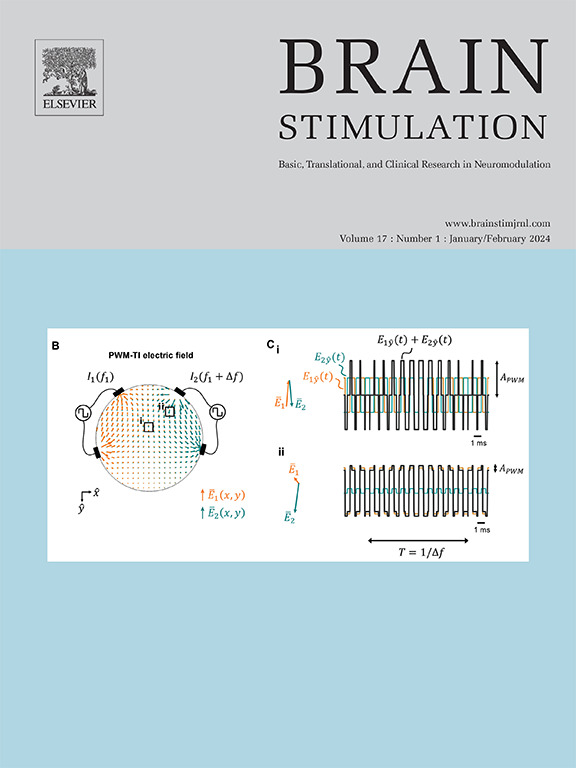运动网络重组与rtms诱导的作家痉挛性肌张力障碍的写作改善有关。
IF 7.6
1区 医学
Q1 CLINICAL NEUROLOGY
引用次数: 0
摘要
背景:Writer's痉挛(WC)肌张力障碍是一种不自主运动障碍,在大脑运动网络中有分布异常。先前的研究确定了重复经颅磁刺激(rTMS)对运动前皮层(PMC)或初级体感皮层(PSC)的潜力,以改善症状。然而,临床效果有限,对神经机制的理解有限,阻碍了这种有前途的方法的治疗进展。目的:本研究旨在了解rTMS对WC的运动网络效应与行为效能的对应关系。我们假设行为效能与运动网络皮层和皮层下区域的调节有关。方法:采用双盲交叉设计,12名WC参与者在三种条件下(假tms、10 Hz PSC-rTMS、10 Hz PMC-rTMS)进行rTMS,同时进行写作任务,以激活张力障碍运动并测量写作流畅性。每次经颅磁刺激后,使用基于任务的fMRI评估大脑连通性。结果:10 Hz rTMS对PSC有显著改善,而对PMC无显著改善。PSC-TMS还显著削弱皮质-基底节区、皮质-小脑和小脑内功能连通性(FC),并增强纹状体FC。PSC和SPC BOLD活性的改变与书写障碍行为的减少有关。结论:10hz rTMS通过重新分配运动网络连通性和增强体感-顶叶连通性改善PSC书写障碍。有效刺激PSC和改善书写障碍的一个关键特征可能是加强初级体感觉皮层和顶叶上皮层之间的皮质内连接。这些发现为促进经颅磁刺激治疗肌张力障碍的应用提供了机制假设。本文章由计算机程序翻译,如有差异,请以英文原文为准。
Motor network reorganization associated with rTMS-induced writing improvement in writer's cramp dystonia
Background
Writer's cramp (WC) dystonia is an involuntary movement disorder with distributed abnormalities in the brain's motor network. Prior studies established the potential for repetitive transcranial magnetic stimulation (rTMS) to either premotor cortex (PMC) or primary somatosensory cortex (PSC) to modify symptoms. However, clinical effects have been modest with limited understanding of the neural mechanisms hindering therapeutic advancement of this promising approach.
Objective
This study aimed to understand the motor network effects of rTMS in WC that correspond with behavioral efficacy. We hypothesized that behavioral efficacy is associated with modulation of cortical and subcortical regions of the motor network.
Methods
In a double-blind, cross-over design, twelve WC participants underwent rTMS in one of three conditions (Sham-TMS, 10 Hz PSC-rTMS, 10 Hz PMC-rTMS) while engaged in a writing task to activate dystonic movements and measure writing fluency. Brain connectivity was evaluated using task-based fMRI after each TMS session.
Results
10 Hz rTMS to PSC, but not PMC, significantly improved writing dysfluency. PSC-TMS also significantly weakened cortico-basal ganglia, cortico-cerebellum, and intra-cerebellum functional connectivity (FC), and strengthened striatal FC relative to Sham. Change in PSC and SPC BOLD activity were associated with reduced dysfluent writing behavior.
Conclusions
10 Hz rTMS to PSC improved writing dysfluency by redistributing motor network connectivity and strengthening somatosensory-parietal connectivity. A key signature for effective stimulation at PSC and improvement in writing dysfluency may be strengthening of intra-cortical connectivity between primary somatosensory and superior parietal cortices. These findings offer mechanistic hypotheses to advance the therapeutic application of TMS for dystonia.
求助全文
通过发布文献求助,成功后即可免费获取论文全文。
去求助
来源期刊

Brain Stimulation
医学-临床神经学
CiteScore
13.10
自引率
9.10%
发文量
256
审稿时长
72 days
期刊介绍:
Brain Stimulation publishes on the entire field of brain stimulation, including noninvasive and invasive techniques and technologies that alter brain function through the use of electrical, magnetic, radiowave, or focally targeted pharmacologic stimulation.
Brain Stimulation aims to be the premier journal for publication of original research in the field of neuromodulation. The journal includes: a) Original articles; b) Short Communications; c) Invited and original reviews; d) Technology and methodological perspectives (reviews of new devices, description of new methods, etc.); and e) Letters to the Editor. Special issues of the journal will be considered based on scientific merit.
 求助内容:
求助内容: 应助结果提醒方式:
应助结果提醒方式:


